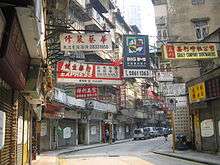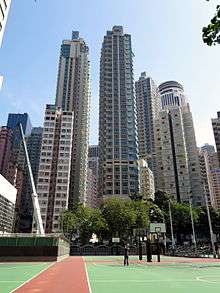Lee Tung Street
| Lee Tung Street | |||||||
 View of Lee Tung Street | |||||||
| Traditional Chinese | 利東街 | ||||||
|---|---|---|---|---|---|---|---|
| Simplified Chinese | 利东街 | ||||||
| |||||||
| Wedding Card Street | |||||||
| Chinese | 喜帖街 | ||||||
| Literal meaning | joyous posters street | ||||||
| |||||||
Lee Tung Street, known as the Wedding Card Street by locals, was a street in Wan Chai, Hong Kong. The street was famed in Hong Kong and abroad as a centre for publishing and for the manufacturing of wedding cards and other similar items.
All interests of this street were resumed by and reverted to the Government of Hong Kong since 1 November 2005. Lee Tung Street was demolished in December 2007 as part of an Urban Renewal Authority (URA) project. The demolition was seen by many as causing irreparable harm to the cultural heritage of Hong Kong.
The site has recently been redeveloped as a luxury shopping and housing development. As with all other URA projects, no original tenants have been resettled on site.
History
The street was known for its printing industry, and Wan Chai was a longtime host of the headquarters of the Hong Kong Times, Ta Kung Pao and Wen Wei Po. In the 1950s, print shops began to gather in Lee Tung Street between Johnston Road and Queen's Road East. Rumours had it that the government of Hong Kong mandated this in order to easily monitor illegal publication.
The famous poet and translator Dai Wangshu also established a short-lived bookstore in Lee Tung Street in the early 1950s.[1]
In the 1970s, the print shops also began producing wedding invitations, lai see, fai chun, and other items, for which they became famous in the 1980s. Hundreds of thousands of Hong Kong people visited the shops there to order their wedding cards, name cards, and traditional Chinese calendars.
Redevelopment
In 2003, the Urban Renewal Authority announced it would spend HK$3.58 billion to redevelop Lee Tung Street and McGregor Street, an area covering 8,900 square metres (96,000 sq ft). According to an authority spokesman, up to the end of June 2005, more than 85 percent of the 647 affected homeowners on Lee Tung Street had agreed to accept compensation offers of HK$4,079 per square foot. The purchase of the land was expected to be completed early 2006. The street was duly demolished starting in December 2007. In its place will stand four high-rise buildings and one underground car park, and new shops fitting in with the proposed image of the street as a “Wedding City”. That means the old shops there, which were mostly small businesses and family-run, had to move elsewhere to continue operating, facing high rent and losing old customers.
On behalf of the H15 Concern Group, architect Christopher Law produced a counter-proposal known as the "Dumbbell Proposal" which would have preserved the signature six-storey tong lau in the middle part of the street. However, despite the proposal and strong protests by residents (including a three-day hunger strike by 60-year-old shop owner May Je) and other activists, the URA and the government went on to demolish the street as planned.[2]
Timeline of Lee Tung Street Renewal scheme
- 1998: The Land Development Corporation announced the Development Scheme Plan including The Lee Tung Street/McGregor Street project (H15)
- 1998: The Town Planning Broad approved the Development Scheme Plan
- 1999: The Chief Executive in Council approved the Development Scheme Plan
- 2001: the Urban Renewal Authority was established and replaced the Land Development Corporation since Land Development Corporation's efficiency in redevelopment was not satisfactory
- 2003: Urban Renewal Authority conducted the occupancy survey
- 2004: Urban Renewal Authority released the letter 8 for the land and property acquisition in the affected area of H15 Renewal Project
- 2005: The H15 group submitted her own renewal proposal i.e. Dumbbell Proposal (啞鈴方案), which was awarded silver award by the Hong Kong Institute of Planners but was rejected by the Town Planning Broad(城規會)
- 2007: H15 group failed to appeal the decision made by Town Planning Broad in the Appeal Board Panel (Town Planning)
- 2009: Urban Renewal Authority started a public tendering for the H15 Urban Renewal Plan
- 2009: The Urban Renewal Authority announced that Sino Land and Hopewell Holdings Limited got the joint development contract, enabling them to develop the H15 Urban Renewal Plan
Procedures and institutions involved
1. Urban Renewal Authority submits a development scheme plan to the Town Planning Board
2. Town Planning Board Secretariat process the submission
3. Town Planning Board decides if the plan submitted is suitable for exhibition or not
4. Town Planning Board arranges a publication of such development scheme plan in the Gazette
5. Town Planning Board publishes the development scheme plan
6. Urban Renewal Authority publishes the development scheme in the Gazette
7. Urban Renewal Authority carry out a freezing survey in the affected area
8. Town Planning Board considers objections to the development scheme plan.
9. Town Planning Board submits the development scheme plan to the Chief Executive in Council
Lee Tung Avenue


In June 2013, the Urban Renewal Authority began accepting applications for new commercial tenants on the street, and formally announced the new name "Avenue Walk" (囍歡里). The Chinese name was a pun on the phrase "I Like You". This pun resulted in widespread derision.[3] Lyricist Wyman Wong was among the critics; in a parody of the lyrics of a Joey Yung song he had written earlier, he stated that the name made him feel miserable and cry (『囍歡里』讓我下沉,『囍歡里』讓我哭). Some internet users extended the pun in an obscene direction by suggesting the opening of a lou mei restaurant in the street called "Avenue Lane Lou Mei Shop" (囍歡里鹵味店);[4] lou mei is a widely known Cantonese minced oath used in maternal insults, making the name roughly equivalent to "I Like Yo Momma". Finally, Hopewell and URA announced the name changed to "Lee Tung Avenue" (利東街) in October 2015, using the street's old Chinese name.
On 28 November 2015, the place was reopened as an outdoor shopping boulevard with one storey of basement mall.
See also
References
- ↑ Lee, Leo Ou-fan (2008). City Between Worlds, My Hong Kong. Cambridge: The Belknap Press of Harvard University Press. p. 94.
- ↑ Chau, Winnie. "Our Town". HK Magazine. Archived from the original on 14 October 2008. Retrieved 2013-06-26.
- ↑ "囍歡里成網民取笑對象". Ming Pao. 2013-06-25. Retrieved 2013-06-26.
- ↑ "囍歡里鹵味店". The House News. 2013-06-26. Retrieved 2013-06-26.
External links
| Wikimedia Commons has media related to Lee Tung Street. |
- Gallery
- Gallery
- 《灣仔街紙》-市區重建策略檢討公民參與文件 | Wan Chai 'Street post' – Urban regeneration strategy public consultation paper (via Project SEE)
Coordinates: 22°16′32.2″N 114°10′20.3″E / 22.275611°N 114.172306°E